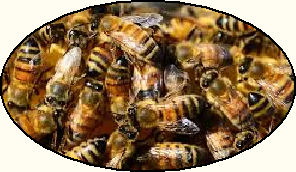Spadina Literary Review — edition 14 page 22
.../
Winston is nowadays the academic director of Simon Fraser University's Centre for Dialogue, which, I gather, helps people communicate. It’s a role he feels the bees prepared him for. After all, the prevalent activity in the hive is communication. And it’s intense. A big part of bees' activity consists of stroking each other’s antennae, licking each other’s tongues, rubbing legs, clambering over each other, and so on, all of which amounts to a non-stop exchange of info, an ongoing “conversation” about hive life.
Bees have language or the equivalent thereof. Foraging bees returning to the hive report their findings in a waggle dance whose precise motions and gestures constitute a phraseology. Other bees learn the distance to a promising floral resource by contemplating the length of the dancer’s straight run, and they learn the direction to the resource by the angle of the dance relative to the sun’s position. The degree of sideways waggling, the intensity of the vibrations, the number of repeats, demonstrate the forager’s faith in the quality of the find.
Alright, so that’s another lesson for us: communication is important. Communication is why bees work together so well. I see how Winston is so intoxicated about bees. “Honeybees,” he says, “have achieved what many of us strive for: a life lived in the moment, enriched by relationships with others and a profound connection with their environment.”

Bees keeping in touch
We’re also drawn to bees because of their “sociality.” Honeybees achieve a level of collective spirit that we aspire to or at least profess to admire. They subordinate individual aspirations to the good of the hive — so much so that the hive seems to function as a single intelligence.
Winston is not at his best when he draws political conclusions based on bee society. Given his home base in British Columbia, I was surprised by his gratuitous remarks on allegedly dysfunctional U.S. politics. But I was especially annoyed by his effort to portray the beehive as a beacon of participatory democracy.
We might sooner have pictured the hive as an autocracy. Generally a colony has a single queen, the sole egg-layer. All the workers in the colony are her daughters, all the drones her sons. A retinue of ten or twelve workers fawns over her, constantly licking and touching their antennae to her, picking up her pheromones. These courtiers then roam about the nest licking and touching antennae with other bees, who in turn lick and touch yet more bees, till the queen’s pheromone is transmitted throughout the nest. This is the chain of communication that keeps the hive’s thousands of workers steadfast and focused.